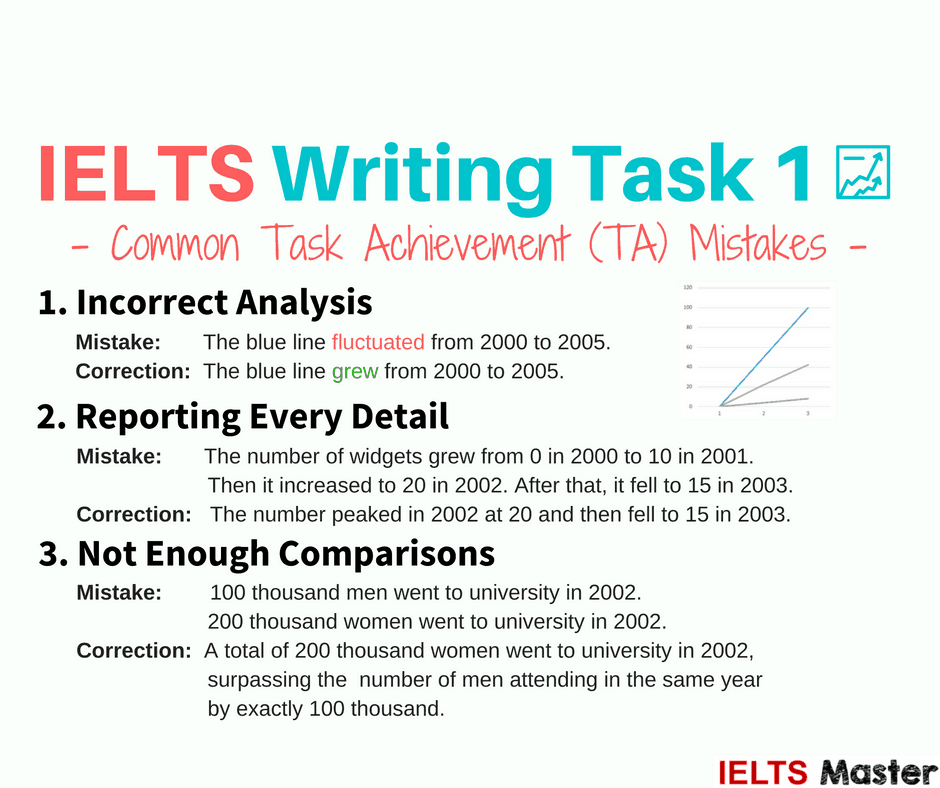Task achievement (TA) is one of four criteria that IELTS writing tasks are judged by.
In this article, I’ll cover the most three common mistakes that prevent IELTS candidates from getting higher task achievement scores in writing task one.
If you can avoid these mistakes, it’s easily possible to get a 7 or better for TA.
Mistake #1: Incorrect Analysis
If you want to get a low task achievement score, the fastest way is to make a mistake when reporting on the graph, table, or diagram.
Take the following graph as an example.
Source: Cambridge IELTS 9
Q: Which one of the following sentences is inaccurate?
a. Mobile usage grew over the period shown.
b. There was a rise in the use of national and international fixed lines.
c. Local fixed line usage fluctuated over the period shown.
If you look carefully, you’ll notice that “c” is the inaccurate sentence.
The definition of to fluctuate is “to rise and fall irregularly in number or amount” (definition link). While local fixed line usage did rise and fall, it was not irregular.
Because of this alone, the task achievement score could drop to a 6 as “details may be irrelevant, inappropriate, or inaccurate.”
Remember: Be careful when analyzing. Even one mistake can hurt your score.
Mistake #2: Reporting Every Detail
You’ve probably heard of this before. You need to “select and report the main features.” Not every detail on the graph.
Don’t do this:
In 1999, 100 million people entered post-graduate programs. In 2000, this number increased to 110 million. By 2001, this number had again increased to 150 million. Finally, in 2002, the number of people in post-graduate programs decreased slightly to 120 million.
You can see in the band descriptions that a task achievement score of 7 will “highlight the main features”, but that a score of 5 “recounts detail mechanically” and that there “may be a tendency to focus on detail.”
There’s no highlighting in this example. It’s just repeating the graph like a robot. This would probably get a 5 for TA, even though the other aspects of the writing are fine.
Remember: Choose the important data to highlight. Don’t report every detail.
Mistake #3: Not Enough Comparisons
While it’s not explicitly written in the band descriptors, the Task 1 writing instructions do say “make comparisons where relevant”. Personally, I see this as part of highlighting the main information.
Every sentence you’re writing should have a purpose. Sometimes it will be to highlight new, important information. Other times it will be to add on extra information by making a comparison.
Make sure you’re linking this extra information to what you’ve already written about.
Let’s look at these examples:
Example 1 (BAD): 100 thousand men went to university in 2002. 200 thousand women went to university in 2002.
Example 2 (GOOD): A total of 200 thousand women went to university in 2002, surpassing the number of men attending in the same year by exactly 100 thousand.
Not only does example 2 have better grammar, vocabulary, and cohesiveness, but it also makes a relevant comparison. Writing like this will get you at least a band 7 score.
Remember: Make comparisons wherever you can.
What mistakes are you making?
If you’d like to have your own writing corrected to see what you’re doing wrong, check out our Writing Correction Service. We can show you exactly what you’re doing wrong and how to fix it.

